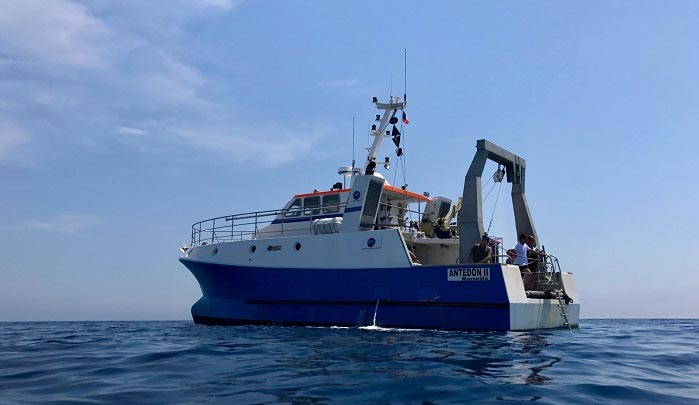On the trail of ocean mercury

The RV Antedon II, belonging to France’s DT INSU-CNRS research fleet. These pictures show the two environments sampled by the researchers, with the aim of applying the same methods in other marine regions.
Credit: © Lars-Eric Heimbürger-Boavida, Mediterranean Institute of Oceanography (CNRS / Aix-Marseille University / IRD / University of Toulon)
Mercury is released by coal combustion and mining activities to the atmosphere as a gaseous pollutant.
Following global dispersal, mercury deposits partly to the ocean where it accumulates within the marine food chain—with grave consequences for human health and nutrition.
A new study published in Nature on 29 September 2021 reveals that, contrary to earlier hypotheses, rainwater is not the primary deposition vector of this mercury; rather, the ocean breathes mercury, so to speak.1
This research also suggests that the ocean receives less atmospheric mercury than previously estimated, though we cannot yet assume a lower degree of contamination in fish. The Minamata Convention on Mercury,2 which went into effect in 2017, has prompted the adoption of mercury emission reduction policies that should directly impact mercury levels in the ocean and in our plates.
This study was conducted by an international team including scientists from Géosciences Environnement Toulouse (CNRS / Université Toulouse III–Paul Sabatier / CNES / IRD), the Mediterranean Institute of Oceanography (CNRS / Aix-Marseille University / IRD / University of Toulon) and the Environmental Geosciences laboratory of the University of Basel (Switzerland).
Notes
1 That is, the mercury is absorbed by the surface waters of the ocean through gas exchange.
2 The international Minamata Convention on Mercury was drafted under the aegis of the United Nations Environment Programme. It aims to protect human health and the environment from the harmful effects of mercury.
Journal: Nature
DOI: 10.1038/s41586-021-03859-8
Article Title: Mercury stable isotopes constrain atmospheric sources to the ocean
Media Contact
Alexiane Agullo
CNRS
alexiane.agullo@cnrs.fr
Original Source
https://www.cnrs.fr/en/trail-ocean-mercury
All latest news from the category: Ecology, The Environment and Conservation
This complex theme deals primarily with interactions between organisms and the environmental factors that impact them, but to a greater extent between individual inanimate environmental factors.
innovations-report offers informative reports and articles on topics such as climate protection, landscape conservation, ecological systems, wildlife and nature parks and ecosystem efficiency and balance.
Newest articles

Innovative 3D printed scaffolds offer new hope for bone healing
Researchers at the Institute for Bioengineering of Catalonia have developed novel 3D printed PLA-CaP scaffolds that promote blood vessel formation, ensuring better healing and regeneration of bone tissue. Bone is…

The surprising role of gut infection in Alzheimer’s disease
ASU- and Banner Alzheimer’s Institute-led study implicates link between a common virus and the disease, which travels from the gut to the brain and may be a target for antiviral…

Molecular gardening: New enzymes discovered for protein modification pruning
How deubiquitinases USP53 and USP54 cleave long polyubiquitin chains and how the former is linked to liver disease in children. Deubiquitinases (DUBs) are enzymes used by cells to trim protein…



